#Morphometrics
Explore tagged Tumblr posts
Text
Occurrence of Pipistrellus tenuis in Goalpara, Assam, India

Abstract
A recent survey identified a colony of Pipistrellus tenuis (n = 5) in Kanyakuchi Pahar village (26°00’32.8″N 90°53’29.0″E), a rural remote site situated at Goalpara district of Assam. This species, commonly known as the Least Pipistrelle, was previously reported by Hinton and Lindsay (1926), Sinha (1999), Ghosh (2008), Saikia et al. (2011) and Boro et al. (2018) from different parts of Assam. The Goalpara district of western Assam is encircled by the foothills of Meghalaya to the South and the Brahmaputra River to the North possesses a variety of flora and fauna due to the dense foliage of the high forest canopy. The climatic condition of the region along with its topography favours roosting of bat population. The distribution of the bat species P. tenuis in the surveyed area has not been previously recorded. For the purpose of taxonomic identification, morphometric parameters (external and cranio-dental measurements) were compared to standard literature by Bates and Harrison (1997). Captured bat specimens (n=3) were examined at the ZSI (Zoological Survey of India), NERC-Shillong, Meghalaya. The recorded mean body weight of captured specimens was 2.61g ± 0.160 (S.D) and the mean forearm length (FA) was 27.39mm ± 0.165 (S.D). This manuscript validates sightings of this bat species at the study location, compares its morphometric and cranio-dental traits to standard literature (Bates and Harrison, 1997) for identification, discusses its distribution as well as its ecological importance.

Introduction
Bats are the only mammals that can fly for long periods of time, making them the second-largest order of mammals with over 1,400 different species. The two suborders of bats, Microchiroptera (echolocating bats) and Megachiroptera (Old World bats) make up the taxonomic group Chiroptera. 127 species of bats from India were listed by Talmale and Saikia (2018) and were categorised into 41 genera and 9 families. About 39 different bat species, divided into 16 genera, are found in Assam, including 34 Microchiropteran species and 5 Megachiropteran species (fruit bats) (Ali, 2022). The Himalaya and Indo-Burma Biodiversity Hotspot, which includes Northeast India, contains 74 species of the 127 species of bats that are known to exist in India (Saikia, 2019). There are nine families in the order Chiroptera that are represented in India: Pteropodidae, Megadermatidae, Hipposideridae, Rhinolophidae, Emballonuridae, Rhinopomatidae, Molossidae, Vespertilionidae, and Miniopteridae.
With 62 species, the family Vespertilionidae (commonly known as evening bats) is the most diverse and numerous family of bats found in India (Saikia 2019; Ali, 2022). The tiniest pipistrelle found in the Indian subcontinent belongs to the Vespertilionidae family and is known as the least pipistrelle (Figs. 2 and 3). The genus Pipistrellus has 51 species worldwide, including 12 species being found on the Indian subcontinent (Koopman, 1993). It's prevalent over the majority of Southeast Asia, Southeast China, and South Asia (Simmons, 2005). This species is found in Pakistan, Bangladesh, Afghanistan, India, Nepal, and Sri Lanka (Molur et al., 2002; Das, 2003; Vanitharanie, 2006; Korad, 2007). This bat occasionally shares a roost with Indian Pipistrelles, but they don't interact with one another. They frequently form colonies of 1 to 25 individuals and are present in both woodlands and populated places and often prefer living in close proximity to human population. They build their nests in trees, leaf canopies, the ceilings or walls of buildings, and abandoned homes (Francis et al., 2010). Seasonal variations in the species' diet are evident.
It consumes a variety of insects and beetles during the monsoon and summer, and termites, cockroaches, wingless ants, and moths during the winter (Hamidullah et al., 2019).
P. tenuis are categorised as insectivorous bats in terms of preferred diet and feeding habits. A typical pipistrelle bat can often consume one-third of its body weight in insects per night, significantly lowering the number of insects. They devour a lot of insects at night, which costs the US $3.7 billion in pest control every year. It has been shown, according to the Smithsonian Tropical Research Institute and the University of Michigan that places with insectivorous bat populations greatly reduce the amount of insects and plant damage (Kalka et al., 2008). Recent study on the reproductive activity of the P. tenuis species indicate that there are two peaks between the months of July and August, and one between February and March. The greatest abundance of prey occurred during each of these times. In China and India, pregnant and nursing females have been spotted at all times of the year, proving that reproduction is possible all year long (Wilson and Mittermeier, 2019). Due to their nocturnal lifestyle and ecological diversity, bats are a fascinating group of animals as well as a difficult species to research.
A number of researchers from the Zoological Survey of India and other institutions have made significant contributions to the study of Indian bat taxonomy and geographic distribution in the post-independence era. Some of the most important revisions of the geographical range and taxonomy of Indian bats include Brosset (1962abc, 1963); Hill and Corbett (1992); Bhat and Kock (1994); Sinha (1970, 1973, 1999); Bates & Harrison (1997); Pradhan (2008); Das (2003); Csorba et al. (2003); Ramarkishna et al. (2003); Ghosh (2005, 2008); Srinivasulu (2001, 2006); Alfred, (2006). A monograph by Bates & Harrison (1997) listed 28 species of bats from Assam. Recently, there are only a few significant works on the study of different species of bats in the state of Assam by Sinha (1999), Ghosh (2008) and Boro et al. (2013; 2015; 2018), Ali (2010; 2022), Rahman and Choudhury (2017), Saikia et al. (2011; 2018; 2019; 2021).
Furthermore, little is known about the distribution and taxonomic status of bats, notably microchiroptera, in the Assam region. This article aims to investigate the distribution and current status of the Pipistrellus genus in Assam's Goalpara district. This paper on Pipistrellus tenuis occurence is the first at the study site (Fig. 1) and is based on measurements of morphometric features in comparison to current standard literature (Bates and Harrison, 1997).
Source : Occurrence of Pipistrellus tenuis in Goalpara, Assam, India | InformativeBD
1 note
·
View note
Text
someone convince me that downloading PDFs is not actually the same thing as working on my dissertation
1K notes
·
View notes
Text
Help Us Do Real Science!
@talesfromtreatment and I have an ask for our fellow corn snake keepers and breeders.
We're gathering information on corn snake size by age and we need community scientists like you to provide the largest possible body of data.
@talesfromtreatment will be using the information gathered to build an accurate, statistics-supported corn snake growth and feeding guide based on ACTUAL data from ACTUAL corn snake keepers like you! I'm just the numbers gal.
Here's what we need:
Your snake's age (in years)
Your snake's weight (in grams)
A top-down photo of your snake's entire body with an inch or centimeter reference. (see photo below)
All of this information entered in our online form, linked below or copy/pasta: https://forms.gle/QtAwmiFa6fpBewFs8
https://forms.gle/QtAwmiFa6fpBewFs8
We'd love to get data on older snakes, younger snakes, fatter snakes, skinnier snakes. If you've got a corn snake we want their age, weight, and a photo of them with a measuring device.
Photos don't need to be fancy, just give us a top-down view of your snake and a ruler/tape measure/yardstick on a flat surface.
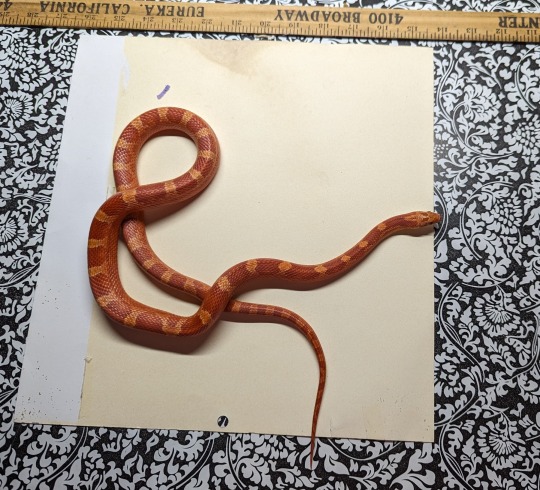
The survey is anonymous and we won't share your photos with anyone nor use them for any purpose beyond collecting morphometric data for this specific study.
Please please please help us collect as much data as possible. Share with your reptile-keeping friends, signal boost, submit your metrics, and stay tuned for updates!
https://forms.gle/QtAwmiFa6fpBewFs8
#snake#snakes#reptile#reptiles#reptiblr#corn snake#corn snakes#corn snake keeping#corn snake husbandry#snake keeping#snake husbandry#snake care#community science#science!!!#science#the link is in here like three times#please help#signal boost#data#herpetology
2K notes
·
View notes
Text

A new species in the Cyrtodactylus intermedius (Squamata: Gekkonidae) group from an isolated limestone karst formation in southwestern Cambodia
SOPHEA CHHIN+ THY NEANG+ SOMALY CHAN+ KIMSRENG KONG+ RATANAK OU+ VISATHA IN+ VIREAK SAMORN+ RATHA SOR+ VANNY LOU+ SOPHA SIN+ MENG CHHIM+ BRYAN L. STUART+ L. LEE GRISMER+
Abstract
The gekkonid lizard Cyrtodactylus intermedius was formerly considered to be a single widespread species in hilly areas across eastern Thailand through southern Vietnam but has recently been partitioned into a complex of 12 nominal species across its range. A population belonging to the C. intermedius group was recently found in an isolated limestone karst block in Kampot Province in southwestern Cambodia, part of which lies within the recently designated Phnom Preah Kuhear Loung Natural Heritage Site. Comparisons of morphometric, meristic, qualitative morphological and color pattern data, as well as a molecular analysis using the mitochondrial ND2 gene, revealed that this population differs from all other named members of the C. intermedius group, and so is described here as a new species. The karst-dwelling C. regicavernicolus sp. nov. was recovered as the sister species to C. laangensis, the most geographically proximate member of the complex and one that is also restricted to a small limestone karst habitat.
Read the paper:
A new species in the Cyrtodactylus intermedius (Squamata: Gekkonidae) group from an isolated limestone karst formation in southwestern Cambodia | Zootaxa (mapress.com)
177 notes
·
View notes
Text

Simplifying the Centrolene buckleyi complex (Amphibia: Anura: Centrolenidae): a taxonomic review and description of two new species
Franco-Mena, De la Riva, et al
Abstract
Centrolenidae is a Neotropical family widely distributed in Central and South America, with its species richness concentrated in the tropical Andes. Several taxonomic problems have been identified within this family, mostly related to species with broad geographic distributions. In this study, we assessed and redefined the species boundaries of the Centrolene buckleyi species complex, and formally described two new species from the Andes of Ecuador. These new taxa are recognized by a combination of morphometric, osteological, acoustic, and genetic data. Following IUCN criteria, we propose that the two new species should to be considered as Endangered (EN), mainly because of their small distributions and habitat loss. The C. buckleyi complex provides insights into the biogeography of closely related Andean species. As in other glassfrogs, speciation in Centrolene seems to be mediated by the linearity of the Andes, where gene flow can be restricted by topography and, also, local extinctions.
Read the paper here:
Simplifying the Centrolene buckleyi complex (Amphibia: Anura: Centrolenidae): a taxonomic review and description of two new species [PeerJ]
128 notes
·
View notes
Text
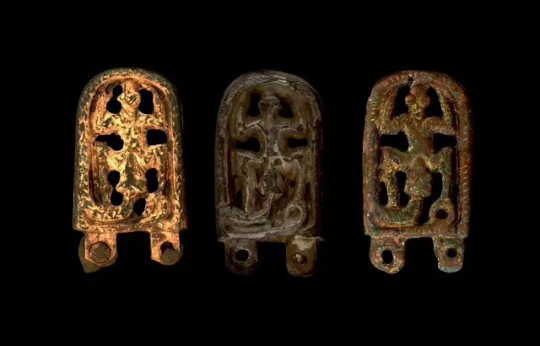
Archaeologists Uncover a Bronze Belt Fitting From an Unknown Pagan Cult
team of archaeologists from Masaryk University have uncovered a bronze belt fitting from an unknown pagan cult in the village of Lány, located in the Central Bohemian Region of the Czech Republic.
The belt fitting dates from the 8th century AD and depicts a snake devouring a frog-like creature that appears in Germanic, Avar, and Slavic mythology.
Such representations are related to the cosmogonic myth of the world’s creation which are found at various sites across Central Europe, while the interaction between the frog and the snake can be linked to fertility cult practices.
According to the researchers, the belt fitting provides evidence of a previously unknown pagan cult that connected diverse populations of varying origins during the early Middle Ages before the advent of Christianity which began in the 9th century AD.
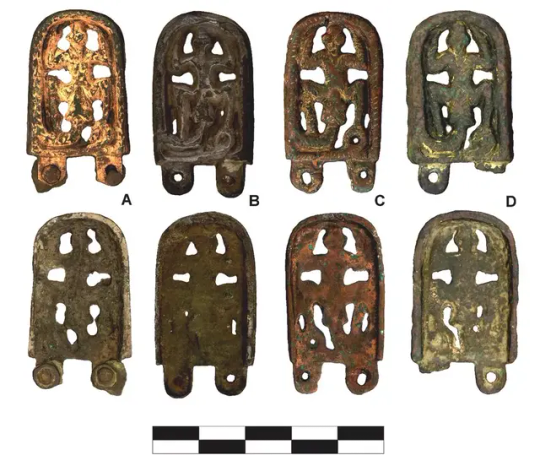
The discovery in Lány belongs to the group of so-called Avar belt fittings, which were mainly produced in Central Europe in the 7th and 8th centuries AD. It was likely worn by an Avar, a Northeast Caucasian ethnic group who settled in the Carpathian Basin, however, it could also be from one of the cultures influenced by Avar cultural practices.
Using an X-ray fluorescence analysis (EDXRF), scanning electron microscopy (SEM), a lead isotope analysis, and 3D digital morphometry, an analysis of the belt fitting revealed that the greater part of the bronze was heavily gilded and was cast by using a wax model.
A chemical analysis of the lead isotopes in the bronze alloy indicates that the copper used in the production was mined in the Slovak Red Mountains, while the morphometric analysis suggests that some of the fittings originate from the same workshop.
The results of the study have been published in the Journal of Archaeological Science.
By Mark Milligan.
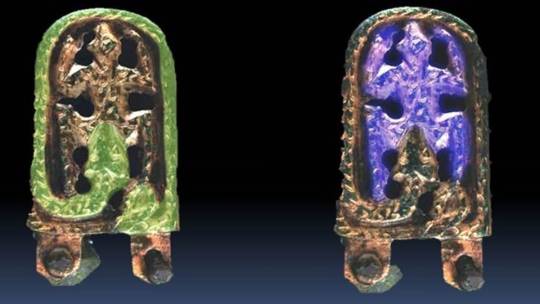
#Archaeologists Uncover a Bronze Belt Fitting From an Unknown Pagan Cult#Czech Republic#village of Lány#bronze#Avar belt fittings#ancient artifacts#archeology#archeolgst#history#history news#ancient history#ancient culture#ancient civilizations#avar culture
49 notes
·
View notes
Text
Woohoo! 🎉 It's happening y'all! I have a supervisor lined up and my formal application is submitted. We're discussing potential projects in more detail now 😃 I'm going to be working on something involving bat skull morphometric analysis. Honours, here I come!
#studyblr#uni#zoology studyblr#studying#honours#going back to school#uni of adelaide#research#bats#chiroptera
4 notes
·
View notes
Text

Greetings folks! This time i have both a advance naval drone and a security breach: meet MANTA RAY Drone.. 🎶I fly in water, lil' Manta Devilfish Manta..🎶 anyways.. :)

First things first this system is a UUV (Unmanned Undersea Vehicle) in 2021 weirdly enough Darpa has started a research program for inspecting the behaviors of adult mantas and measuring them.. specifically.. and just few mounts later we heard a project that grumman and darpa has a project on a demonstration called Aerodynamic Analysis of Manta Ray Inspired Fixed and Flapping-Wing Drones for High Altitude
A submerged vehicle design to deceive radars and sonars and surveillance enemy vessels stealthly. Appearantly we dont know *cant say* its technical capabilities much but this system is kinda effective for deceiving visual and sonar scans of submarine and large vessels by its shape. Clever right? something of a project that should be hidden from any surveillance right?


i mean.. image explains itself.. Apparently, our folks at google has breach the rules of agreement of censoring the military bases.. Again..
and just guess what happened right after..
but right after this article is posted they made a 360 view of the vehicle
youtube
im not gonna say anything more this thing is become more ridiculous with every thing they add up to..
a little personal note: we are literally dancing with media, bringing multiple false topics each time we are infront of a interview and sometimes even disguise ourselves each time we are outside, using multiple layers of layers online security measures to hide a fucking 3d printer's existence and when i see something like this.. i cant help it and LOSE MY MİND!! Dude, god please at least do something regards to meaningless and useless NDA of yours!!
phew.. im ok! im fine..
so here is your sources:
#tech#tech news#daily news#cyberpunk#scifi tech#microsoft#aim#microsoft aim#research#rnd#r&d#darpa#manta#manta ray#drone#Youtube
2 notes
·
View notes
Text
found myself belligerently staring at google maps today looking at some massive unnamed seamounts off the coast of scotland and thinking surely these must have been named. surely. if only because they are so big.
anyways they ARE named (this is the site for the naming of bathymetric features; pity google does not have an option to view these: https://www.ngdc.noaa.gov/gazetteer/ ) and look at what I found on the rockall plateau:

also quite appallingly from my quick 3am skim of google scholar there seem to be very few morphometric studies of sea floor features and even fewer geomorphological maps. would be SO interesting to do especially as these sorts of studies – based off morphology alone – are excellent for comparative planetology, except of course on Earth one can ground truth observations with (comparatively) easy sampling. This would be particularly useful for Venus – the higher atmospheric pressure suppresses vesiculation, so you get less explosive volcanism (lavas >> pyroclasts). Submarine volcanism would provide a pressure analogue to that. Pressures are 92 atm at the Venusian surface, which is about the same as volcanism 1km underwater on Earth – remembering that despite 3-4km depths here these seamounts have sunken, and so do not represent the water depths at the time of formation (hotter more buoyant crust during volcanism; cooling and subsidence after etc etc).
and LOOK at this beauty, the Edoras Bank – a chain of seamounts (sunken and eroded volcanoes) following a lineament. It's a shorter scale alignment than, e.g. the Emperor Seamount chain (c.2000km tracking plate motions over a stationary plume) so it's possible that the difference by an order of magnitude accounts for different genetic processes e.g. fault-controlled volcanism. Need to find a paper or something to find out.


And look at this, zoomed in – TONS of parasitic seamounts and guyots. Of course, on Earth things are very much shaped by erosion (on Venus the effects are much smaller). Also very interesting that there is one very sizeable seamount and a chain of smaller seamounts trailing on. Reminds me of pit crater "tadpole" chains on Venus (though that's a negative relief feature, while this is positive).

I'm rambling and really this has not much of a point (started with oh look, tolkien names and ended with venus rambles). Feel like I want to maybe in my spare time start digitising bits of this. Morphological mapping of the seafloor and whatnot on QGIS may be just the fun I need when procrastinating. also it's now 4am goodnight.
6 notes
·
View notes
Text
The earliest Ethiopian wolf: implications for the species evolution and its future survival.
Published May 1st 2023
Remains of an ethiopian wolf estimated to be 1.6-1.4 million years old based on a right mandible found in the melka wakena formation of Southeastern Ethiopian Highlands, Africa. Studies on this specimen provides interesting insight on the evolution of this species when compared to other extant relatives and its modern counterpart.

Location and stratigraphy of the site of Melka Wakena, and stratigraphic position of Canis simensis fossil
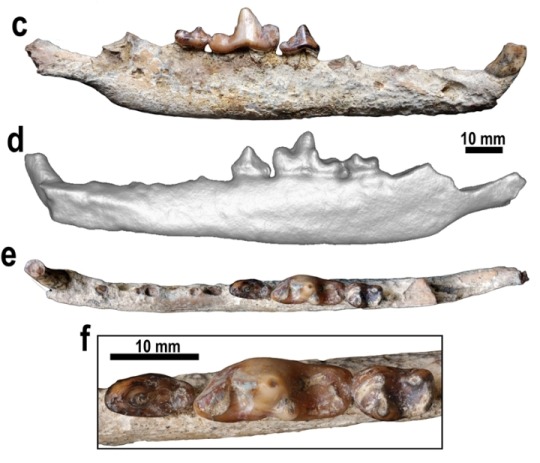
Right mandible of Canis simensis

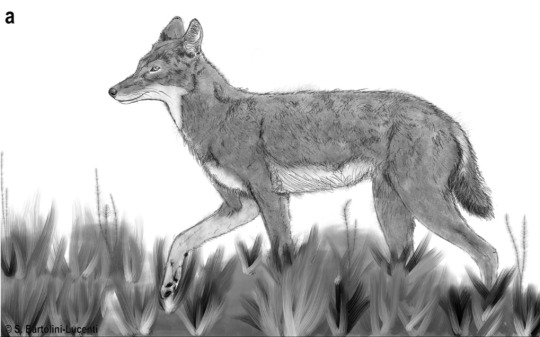
Canis simensis silhouette, and artist's drawing of Canis simensis by S. Bartolini-Lucenti.


Canis simensis, from


Morphology of different Plio-Pleistocene and extant African canid mandibles, and Morphometric comparison analyses of the mandible
Source:
7 notes
·
View notes
Link
1 note
·
View note
Text
I've seen this discourse a few times and there's some truth to what the OP says, but also falls into something that I see a lot when lay people discuss hot button topics. The way this is phrased makes it seem like this is the end all be all of the research regarding the topic and that it was debunked and/or should be dismissed as pseudoscience. If this is not the OPs intent then that's misinterpreting their words. However, many people cite this type of post to dismiss any discussion of immaturity below the age of 25 and you will consistently see proclamations of "nuh uh, that was debunked!" Here's the problem. This isn't Wakefield's antivaxx for money studies. This is neuroscience that has continued to be researched. In fact, the study that is most likely being referenced in this post and from where we get the mid 20s maturation estimation is from the early days of this particular subject matter and was published in 2005. Read that again. 2005 is when The Adolescent Brain: A Work in Progress was published by Daniel Weinberger, Brita Elvegag, and Jay Giedd.
(Link: http://www.kvccdocs.com/KVCC/2018-Summer/PSY215/lessons/L-19/adol-brain.pdf) Do you think the research stopped? Do you think only these people did this type of research? Let's focus on Jay Giedd as he is the one who made the 25 years of age comment in various interviews. He is the one that pops up if you Google anything relating to this. Dr. Giedd is one of the primary researchers, authors, and experts on this subject matter and has continued his research since then. He is the one that has proposed that adulthood should be considered sometime in the mid 20s, that we see certain developmental milestones (maturations) around this time. He even references other papers around this time that supported the concept of immaturity in young adults under the age of 25 through other studies and means (Sowell et al., 2004 https://pubmed.ncbi.nlm.nih.gov/15385605/).
Philip Shaw et al., 2006. Intellectual ability and cortical development in children and adolescents. (https://local.psy.miami.edu/faculty/dmessinger/c_c/rsrcs/rdgs/emot/Shaw2006Nature.pdf)
-Jay Giedd is on this team
Philip Shaw et al., 2008. Neurodevelopmental Trajectories of the Human Cerebral Cortex. (https://www.jneurosci.org/content/jneuro/28/14/3586.full.pdf)
-This has Jay Giedd on the team
Henning Tiemeier et al., 2010. Cerebellum development during childhood and adolescence: a longitudinal morphometric MRI study. (https://www.ncbi.nlm.nih.gov/pmc/articles/PMC2775156/)
-More Jay Giedd
Armin Raznahan et al., 2011. Patterns of Coordinated Anatomical Change in Human Cortical Development: A Longitudinal Neuroimaging Study of Maturational Coupling. (https://www.cell.com/neuron/pdf/S0896-6273(11)00882-8.pdf)
-Jay Giedd is everywhere
Armin Raznahan et al., 2011. How Does Your Cortex Grow? (https://www.jneurosci.org/content/jneuro/31/19/7174.full.pdf)
-Jay Giedd could be in your house right now
Aaron Alexander-Bloch et al., 2013. The Convergence of Maturational Change and Structural Covariance in Human Cortical Networks. (https://www.tumblr.com/reblog/biglawbear/752594774072213504/zLSathAQ)
-Guess who is part of this one as well. All of these papers are looking at the structural development of the brain in adolescents and young adults. One of the issues that is brought up by OP is that the media ran with terminology and latched on to a certain number, thus building a mythos around it. The issue is that the word "maturation" is used throughout all of these studies. They are talking about the "maturation" of the PFC repeatedly. To the lay audience the term maturation means emotional and intellectual maturity, they think about it in regards to the behavior of children and teens vs adults. They're not thinking about it in terms of physical and physiological development, especially when it comes to neuro studies that may or may not have implications on emotional and intellectual development (maturity as the lay audience defines it). We know from these types of physiological studies that the mid 20s has a milestone where the physiological development of the PCF appears to reach its full volumetric potential in the biggest sense, and that more minor developments continue throughout life within this region and others. But does this really coincide with "maturity" as the lay audience would define it? Well other studies by other research groups do indicate that young adults do resemble teenagers in their way of thinking and approaching certain things. They have found that yes, in fact, young adults are still immature and that their way of behaving, thinking, and regulating does not "mature" until somewhere in the mid 20s. Alexandra Cohen et al., found that young adults aged 18-21 responded like young teenagers (13-14) when presented with continued negative stimuli compared to adults over the age of 21. There is noticeable shifts in cognitive control and capabilities, with emphasis increased emotional responses according to this study.(2016. https://escholarship.org/content/qt3z73902h/qt3z73902h_noSplash_c61ff86f7ba37a154bd56b940659b45a.pdf)
Laurence Steinberg et al., found that the behaviors associated with adolescence and immature self regulation decline as an individual gets older and begins to decrease dramatically and plateau between the ages of 23-26 (2018. https://www.ncbi.nlm.nih.gov/pmc/articles/PMC6473801/). Do these studies indicate that 25 is a magic number of maturity? Of course not. That number is once again due to Jay Giedd doing interviews, making statements, and the inability of non-experts to differentiate what "maturation" means in the context of the published developmental studies. This image encapsulates what happens with any science that goes mainstream

But the literature does indicate and support the claim that before a certain period of time in your mid 20s that you are immature. You still behave, act, think, and respond immaturely. This is not a bad thing, but it does indicate that your capacity to respond to certain things is just not the same as someone above a certain age threshold. So when you scream "I'm not a teenager anymore mom!" at age 20 at your parents, keep in mind that your brain and behaviors more closely resemble a young teen's than they do someone above 23. That's why you're constantly getting called immature under certain conditions, your brain is still reacting a certain way.
The whole "the brain isn't fully mature until age 25" bit is actually a fairly impressive bit of psuedoscience for how incredibly stupid the way it misinterprets the data it's based on is.
Okay, so: there's a part of the human brain called the "prefrontal cortex" which is, among other things, responsible for executive function and impulse control. Like most parts of the brain, it undergoes active "rewiring" over time (i.e., pruning unused neural connections and establishing new ones), and in the case of the prefrontal cortex in particular, this rewiring sharply accelerates during puberty.
Because the pace of rewiring in the prefrontal cortex is linked to specific developmental milestones, it was hypothesised that it would slow down and eventually stop in adulthood. However, the process can't be directly observed; the only way to tell how much neural rewiring is taking place in a particular part of the brain is to compare multiple brain scans of the same individual performed over a period of time.
Thus, something called a "longitudinal study" was commissioned: the same individuals would undergo regular brain scans over a period of mayn years, beginning in early childhood, so that their prefrontal development could accurately be tracked.
The longitudinal study was originally planned to follow its subjects up to age 21. However, when the predicted cessation of prefrontal rewiring was not observed by age 21, additional funding was obtained, and the study period was extended to age 25. The predicted cessation of prefrontal development wasn't observed by age 25, either, at which point the study was terminated.
When the mainstream press got hold of these results, the conclusion that prefrontal rewiring continues at least until age 25 was reported as prefrontal development finishing at age 25. Critically, this is the exact opposite of what the study actually concluded. The study was unable to identify a stopping point for prefrontal development because no such stopping point was observed for any subject during the study period. The only significance of the age 25 is that no subjects were tracked beyond this age because the study ran out of funding!
I gets me when people try to argue against the neuroscience-proves-everybody-under-25-is-a-child talking point by claiming that it's merely an average, or that prefrontal development doesn't tell the whole story. Like, no, it's not an average – it's just bullshit. There's no evidence that the cited phenomenon exists at all; if there is an age where prefrontal rewiring levels off and stops (and it's not clear that there is), we don't know what age that is; we merely know that it must be older than 25.
#neuroscience#scientific literacy#Continuing research#Ya'll need to stop relying upon singular studies and learn that science is a collaborative continual effort of research#Learn to read papers and read the papers that they cite
27K notes
·
View notes
Text
Abstract— The article is devoted to giant fusiform cells of the brain (or giant spindles), neurons that are believed to play an important role in the implementation of the most complex forms of human psyche. Current data on the location, morphological and morphometric peculiarities, molecular phenotype of these neurons, as well as on the size, tangential, radial, and interspecific distribution, and ontogenetic and age dynamics of their population, are examine in detail in the work. The problem of definition and identification of giant spindles as a separate type of brain neurons is covered in detail. The possible functions of giant spindles are considered, especially from the point of view of the function of the areas of their preferential location (frontoinsular and anterior cingulate cortex). Available data on a possible involvement of giant spindles in mental and neurological pathology are also collected. In the second part of the article, the issue of the discovery of giant spindles and the role of outstanding neuromorphologists (V. Betz, S. Ramon y Cajal, and C. von Economo) in the description of these cells are discussed in detail. Based on the analysis of existing works and evidence of modern researchers, we demonstrate that Volodymyr Betz provided the first concise description of the localization and morphology of giant spindles, which from a modern point of view, can be considered sufficient to designate these cells as a separate population of spindle-shaped neurons of the brain.
#giantfusiformcellsofthebrain#cerebralcortex#cytoarchitectonics#comparativebiology#historyofneuroscience#VolodymyrBetz#SantiagoRamonyCajal#ConstantinvonEconomo
0 notes
Photo
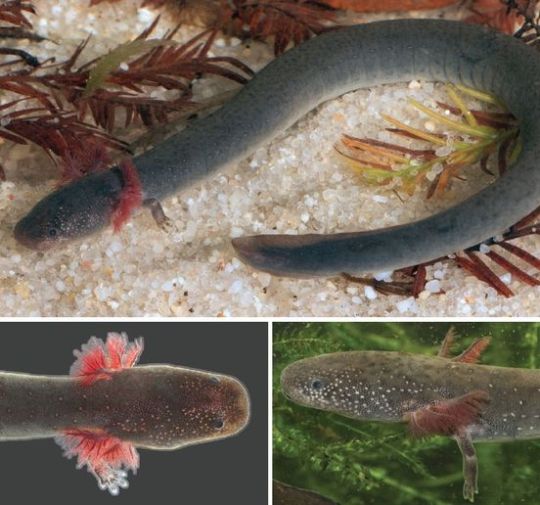
BIG NEWS IN SALAMANDER TAXONOMY!
Unraveling Siren (Caudata: Sirenidae) systematics and description of a small, seepage specialist
Fedler, Enge, and Moler
Abstract
For approximately four decades, scientists have known of the existence of several undescribed species of Siren in the southeastern United States Coastal Plain.
One of these species, S. reticulata, was recently described, but a small, seepage-dwelling species has remained undescribed until now.
To resolve outstanding questions concerning the phylogeny of Siren, we collected sequence and morphometric data from specimens across the range of Siren.
We found S. lacertina and S. reticulata to represent strongly supported monophyletic groups, with S. reticulata having a sister relationship to all other Siren. Additionally, we found five distinct mtDNA lineages within what has been recognized as S. intermedia. Siren lacertina and type-locality S. intermedia (lineage A) are sister mtDNA lineages, whereas S. intermedia lineages B and C show a high level of mitogenomic divergence from type-locality S. intermedia.
Analyses of two scnDNA loci revealed that S. lacertina is monophyletic but nested with low positional support in a clade including the three S. intermedia mtDNA lineages. Further study is needed to determine whether S. intermedia lineages A, B, and C represent distinct species or incompletely sorted lineages.
We restrict the range of S. intermedia to the region from the Escambia and Perdido river drainages of Florida and Alabama eastward through Virginia (the combined ranges of lineages A, B, and C).
We also elevate S. i. nettingi (lineage E) to species status and include the larger S. i. texana form in that taxon, generating a species that occurs from the Mobile Bay drainages westward through the Mississippi Basin and southwest into northeastern Mexico.
Lastly, we describe a new miniature species, S. sphagnicola, that ranges from the Florida Parishes of Louisiana eastward to the westernmost tributary creeks of Choctawhatchee Bay in the western Florida panhandle.
Read more here:
https://mapress.com/zt/article/view/zootaxa.5258.4.1
224 notes
·
View notes
Text
Fwd: Other: 3DImagingAwards.WesternNorthAmericaMammals.DueJan8
Begin forwarded message: > From: [email protected] > Subject: Other: 3DImagingAwards.WesternNorthAmericaMammals.DueJan8 > Date: 7 November 2024 at 06:13:30 GMT > To: [email protected] > > > > > Mammal-oriented evolutionary biologists, we are pleased to share > an opportunity that may be of interest for yourself, your labs, > or collaborators who are conducting morphometric and/or trait-based > research on mammals of Western North America. I am happy to answer any > and all questions off-thread. > > > The Ranges Digitization Network (https://ift.tt/WqMe3Pb) is pleased > to announce the *second annual call* for the *Ranges Imaging Mini-Awards*. > > Ranges is an NSF-funded effort (DBI-2228385) to digitize morphological and > life history traits from over one million mammal specimens from 20 natural > history museums, with a focus on western North America. The project is > allowing researchers to build better baselines for biodiversity, expand > the utility of specimens for new trait-based knowledge and discovery, > and improve predictions of how mammals respond to changing environments > beyond spatial characteristics alone. > > Ranges Imaging Mini-Awards are designed to fund researchers to produce > images of mammal specimens which can extend their current research > through collection of internal and potentially complex trait data at the > intraspecific level. Preference is given to proposals and imagery that > can be integrated with the other specimen-level trait data being digitized > by Ranges . Faculty, staff, postdocs, > students or researchers affiliated with an U.S. institution are encouraged > to apply for this award to produce imagery via ?CT scanning, diceCT, > laser scanning or photogrammetry for trait-focused research. Projects > focused on any aspect of morphological variation are welcome. > > Applications are now being accepted. Learn more at ( > https://ift.tt/q9SH2Gl). > > DEADLINE: *Applications must be submitted by January 8, 2025, 11:59pm > Pacific Time*. > > -Bryan > > > [email protected] > > (to subscribe/unsubscribe the EvolDir send mail to > [email protected]
0 notes
Text
Ancient Seeds Spill the Secrets of French Wine
Ancient Seeds Spill the Secrets of French Wine https://ift.tt/Wq61F7e France might seem like the home of wine, but this wasn’t always the case. Wine drinking became a part of culture in the region from around 600 BCE, when the ancient Greeks founded a colony, Massalia (modern Marseilles) in the south of France. Wine drinking spread from here into inland France, but how? Bouby and colleagues examined the shapes of over 19,000 ancient grape seeds from sites across France to find out. Bouby and colleagues found a dramatic shift in seed shape between the Bronze and Iron Ages, which coincides with southern France trading more with other Mediterranean cultures. Estimated berry sizes increased sharply during the Iron Age, reaching their peak in Roman times. Early French vineyards contained a mix of eastern and western European grape types. They also found that wild-like grapevines remained common in early vineyards, suggesting ongoing domestication processes. The researchers analysed shapes and sizes of ancient grape seeds using imaging and statistical techniques. They then compared ancient seeds to a reference collection of modern wild and cultivated grape varieties. This allowed them to determine if seeds came from wild or domestic grapes and identify different variety groups. This study provides the most comprehensive look yet at how grape varieties changed over time in ancient France. It shows viticulture spread from Mediterranean regions to northern France, with varieties adapted to new climates. It also shows that the people adopting viticulture were hardly passive in the process. The mix of grape types shows complex processes of trade, migration and local adaptation. Despite thousands of registered varieties, current cultivated grape diversity may represent only a fraction of past diversity, that gradually concentrated around elite cultivars with close parental relationships. Surveys in historic wine regions may reveal the extent of ancient diversity in traditional agrosystems, including well-known regional and foreign varieties, as well as previously unknown varieties grown from seeds or cultivated V. sylvestris plants. Bouby, L., Bonhomme, V., Ivorra, S., Bacilieri, R., Ben Makhad, S., Bonnaire, E., … & Terral, J. F. (2024). Seed morphometrics unravels the evolutionary history of grapevine in France. Scientific Reports, 14(1), 22207. https://doi.org/10.1038/s41598-024-72692-6 (OA) Cross-posted to Bluesky, Mastodon & Threads. The post Ancient Seeds Spill the Secrets of French Wine appeared first on Botany One. via Botany One https://botany.one/ October 01, 2024 at 08:30PM
0 notes